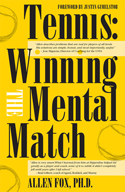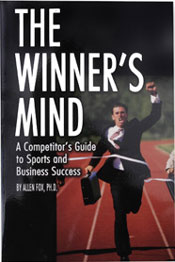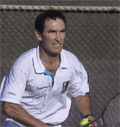Playing the Greats:
Manuel Santana
By Allen Fox, Ph.D.
 |
Was Manuel Santana the greatest Spanish player of all time? |
Spain 's Manuel Santana was, along with Rod Laver, a forerunner of today's game in many ways. By winning the French Championship in 1961 and 1964, Wimbledon in 1966, and the U.S. Championship in 1965, he was an early vanguard of today's "Spanish Armada" and is arguably the greatest Spanish tennis player of all time.
Moreover, Santana's style of play was also prescient of today's players. He was a baseliner, and like his present countrymen, Santana hit both forehand and backhand with topspin.
Because so many of the major tournaments were played on grass at the time, Santana was somewhat more adept at the net than most of today's baseliners but that was not his strength. He was a good but not great volleyer. He beat his net-rushing contemporaries not by volleying better than they did, but by passing them and lobbing them better than they could pass and lob him.
He had great hands, deft touch and wonderful control over the ball. Santana did not usually serve and volley unless he was playing on grass. On clay he would generally start the proceedings on the baseline by flicking in a few deep topspins and then vary the pace with a biting slice or two.
 |
Although he usually only served and volleyed on grass, Santana had much better volleys than most baseliners. |
He was a master of spin and angle and would maneuver opponents into awkward positions with a bag full of varied, cunning and imaginative strokes. Then, as today's players do, he would step around and crack a forehand, his killing weapon, which he could hit flat and with tremendous velocity.
Santana had many ways to make life miserable for his opponents on the slower surfaces. He was one of the first players of his time to make frequent use of topspin lobs and mixed them in cleverly with his sharply angled topspin passing shots.
This created a formidable impediment for aggressive opponents, who generally made a living by coming to net on their opponent's sliced or flat backhands. Santana's diabolical variety of defensive measures contrasted sharply with the somewhat predictable, albeit consistent and punishing, defenses of his opponents. In short, Santana was not fun to play.
I was fortunate enough to avoid having to play him on clay and played him only on California concrete, which was my best surface and his worst. Concrete, particularly the slick, fast concrete prevalent before the Open Era, was not kind to players who relied on spin or who liked to stay on the baseline.
The ball did not "grab" on the smooth court surface as it did on clay or grass. In addition, the Wilson "regular" balls that were used in California tournaments at the time were lighter and had less nap than today's heavy duty balls, so spin was less effective when the ball was in the air.
And the speed of the court and balls made it a volleyer's surface. It paid to get into the net quickly and volley deep. All of these things made Santana vulnerable on concrete. It was only on clay that playing him was truly nightmarish.
Santana did not hit the ball terribly hard and although he rarely missed, I did not feel greatly threatened coming to net on my serve. On the other hand, I did not get many "cheap" points where Santana made an error or hit a shot that was easy to put away. I had to scramble and dive at the net all the time, but I never felt overpowered by any part of Santana's game, they way I did against Stan Smith or Arthur Ashe, who constantly slugged balls by me.
 |
His killing weapon was his flat, fast forehand. |
Playing him was more a contest of movement and cunning than power. Santana maneuvered balls into difficult positions and took advantage of the openings he created but I never got that utterly helpless feeling that Ashe or Smith gave me when they got hot.
Santana's serve was sharp and accurate. He could certainly ace you now and then and he generally kept you off-balance with it, it was not a fearsome weapon as were the serves of Ashe, Newcombe, Gonzales, and Smith. Santana's service action was about equivalent in effectiveness to Rod Laver's. Like Laver's serve it was slick, deceptive, and penetrating, but not a bomb.
We played twice on concrete and split matches. I got him first in Los Angeles at the Pacific Southwest tournament and he got me the next week at Berkeley
.I have to confess that my win over him was slightly tainted by conditions. We played on a typical smoggy Los Angeles day at the Los Angeles Tennis Club and he wasn't quit ready for the fast conditions. The first set turned into a marathon and I eventually won it 10 - 8.
By the end of the set the smog had started to get him. As a native of Los Angeles , I had developed leather lungs while Manuel, who grew up in the Spanish seaside town of La Coruna , was accustomed to air containing oxygen instead of exhaust particles. To my great joy, he made only a token effort in the second set. Unfortunately, the next week he played better and beat me in straight sets.
 |
Santana was a master of spin and had great hands and ball control. |
I felt fortunate to avoid playing him on clay in 1965 when we both played in the Swedish Championships at Baastad. I lost to Roy Emerson in the semi-final, the winner to face Santana in the final. The next day I saw Santana utterly dismember Emerson, who had won Wimbledon just a week earlier.
I had never seen a player of Emerson's caliber made to look so helpless. He was whipped all over the court by Santana who hit topspin lobs over his head, flicked angled topspin passing shots by the bewildered Emerson and even had the gall, at times, to toy with the Wimbledon champion.
At one stage Santana even used a trick shot he invented. Master of spin that he was, Santana took a short ball and hit a backhand dropshot with a full swing and tremendous backspin. The ball hit the court on Emerson's side and then bounced back across the net while Emerson stood transfixed.
It was a shot the ordinary person might try a thousand times and make once. Santana had the nerve to make it in the final of a major tournament and against the best player in the world. As I watched him torture Emerson I could only thank my lucky stars I had lost the day before. Since I didn't have the power of an Emerson, I would have been even more helpless. I could just imagine him running me around until my tongue hung out making me look like a fool.
 |
His serve was sharp and accurate, as effective as Rod Laver's. |
On the tennis court Santana was rough customer. Off the court, like most of the top players of the time, he was a nice guy and great gentleman.
If, as a fellow player, you went to Spain , Santana was a wonderful host. Even though he might be a far better player than you were he was often kind enough to show you around and treat you to a meal at a fine Spanish restaurant.
But if you were on the court with him, watch out! He had a way of hanging his head after he made a great shot that was a kind of fake modest look. "How could I be so lucky?" he seemed to say and the crowd bought it. His opponent, however, knew that Santana was just toying with his brain - trying to dominate him and make him feel foolish.
Charlie Pasarell, who was a good friend of Santana's off the court, told me about a doubles match they played against each other. It so happened that Pasarell got a number of bad line calls from a particular linesman and was complaining to the umpire in an effort to have the offending linesman removed.
The umpire did not see it Pasarell's way and Charlie was fuming as they changed sides. Santana, in a masterful display of false sympathy, told Charlie he was absolutely correct. He HAD been getting screwed all match. Of course this made Charlie all the more angry with the linesman, more mistrustful of his calls and more prone to think about the calls rather than about how to win the match. It was Santana's way of controlling Pasarell's mind and psychologically dominating the match.
Santana's tendency to play mental cat and mouse games with his opponent was in stark contrast to Roy Emerson's approach of simply beating your brains out as quickly as possible. There was nothing personal going on with Emerson. He just wanted to win the match with a minimum of fuss so he could get off the court to have a few beers.
 |
He won Wimbledon and the US on grass, but on clay he was among the best players of all time. |
Santana, on the other hand, had a need to toy with you when he could and bring you to your knees psychologically. He used to do this to his good friend Cliff Drysdale from time to time. Cliff was a gifted player but suffered from slight slowness of foot and insufficient conditioning work. On clay, Santana used to enjoy dropshotting Cliff and then lobbing over his head again and again until Cliff was exhausted and embarrassed.
How good was Santana compared to the other great players of the past? Although he won Wimbledon and the US Championship on grass, he was not, in my opinion, equal to Newcombe, Emerson, Smith or any of the other first rank players on this surface.
On clay, however, it was a different matter, and I would have bet on him against any of them. It was very difficult to attack him on that slow surface, but if an opponent were incredibly steady and in superb physical condition he might be able to wear Santana down. In my opinion he would have ranked among the top ten players of all time on clay - not as good as the inhumanly great Bjorn Borg - but no worse than an even bet against anyone else on that surface.






